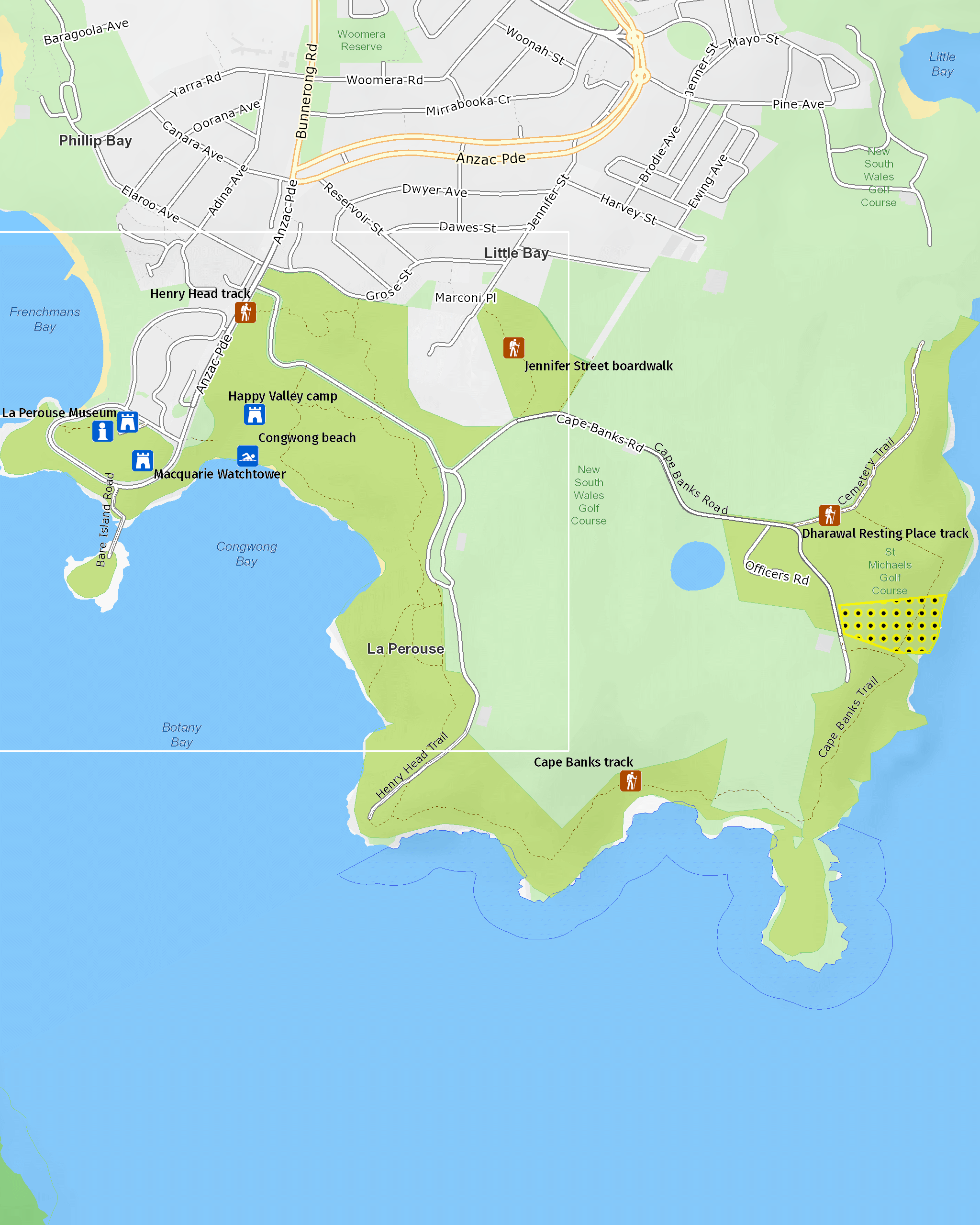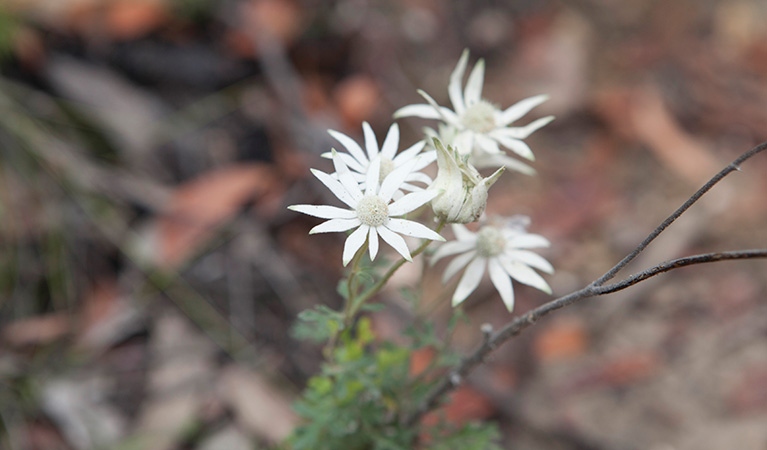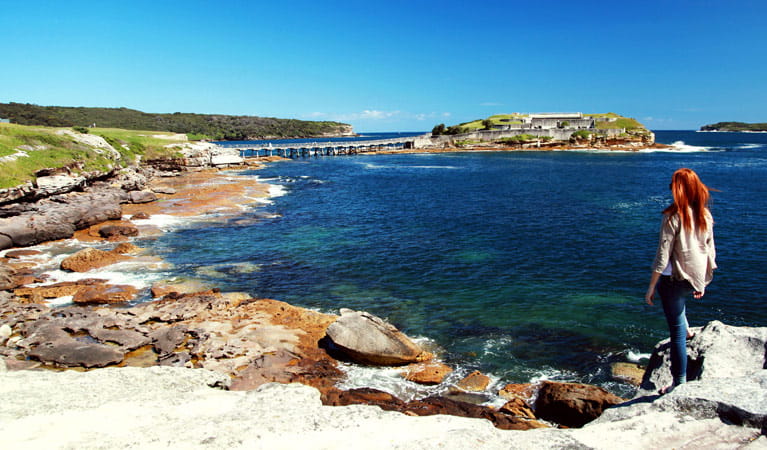La Perouse area
Kamay Botany Bay National Park
Overview
La Perouse is the northern headland of Kamay Botany Bay National Park, near Maroubra. You'll find fantastic walks, diving spots and historic sites just a quick trip from Sydney's centre.
Read more about La Perouse area
The area was named after the French explorer who arrived in Botany Bay a week after the First Fleet, and whose disappearance was a long held mystery. Find out about the area’s history and Aboriginal culture at La Perouse Museum (open Sundays only), or take a guided tour of Bare Island Fort.
The best scuba diving and snorkelling spots are around the La Perouse headland and Bare Island. If you’re feeling energetic, strap on your boots and hike the coastal Henry Head walking track from Anzac Parade to Cape Banks via the Endeavour Lighthouse.
Pack a picnic dinner to enjoy at La Perouse Point as the sun sets, with scenic views of Botany Bay, Kurnell and the Pacific Ocean – where
Captain Cook and Comte de Lapérouse sailed from all those years ago.
Local alerts
For the latest updates on fires, closures and other alerts in this area, see https://www.nationalparks.nsw.gov.au/visit-a-park/parks/la-perouse-area/local-alerts
Map

Map

Map legend

Contact
- in Kamay Botany Bay National Park in the Sydney and surrounds region
7am–8.30pm November to March.
7am–7.30pm April to October.
La Perouse park entry gate closed to vehicles between 7pm and 5am all year.
Areas may have to close at times due to poor weather or fire danger.
-
There are no park entry fees in La Perouse area but you'll need to pay to tour Bare Island. Park entry fees apply in the Kurnell area of Kamay Botany Bay National Park, only.
Buy annual pass. -
-
Nielsen Park office
02 9337 5511
Contact hours: Monday to Friday, 9am to 5pm. - Greycliffe House, Nielsen Park, 6 Steele Point Road, Vaucluse NSW 2030
-
Email: npws.sydneysouth@environment.nsw.gov.au
-
Nielsen Park office
Visitor info
All the practical information you need to know about the La Perouse area.
Maps and downloads
Learn more
La Perouse area is a special place. Here are just some of the reasons why:
Aboriginal culture

At the time of the first encounters with Europeans, Aboriginal people of 2 different nations - the Goorawal People and the Gweagal People - were living in the area which now includes Kamay Botany Bay National Park. Over 30 Aboriginal sites have been recorded in the park, including rock art and engravings.
- Blak Markets at Bare Island Visit Blak Markets at La Perouse, to discover the best of Aboriginal culture. There'll be traditional dance performances, arts and craft stalls, weaving and bush tucker.
- Dharawal Resting Place track Walk the short track to Dharawal Resting Place to discover this important La Perouse Aboriginal site, that’s also steeped in Sydney’s colonial history.
Historic heritage

Two of Australia's earliest European explorers landed in Botany Bay here—James Cook in 1770, and the Comte de Laperouse in 1788. Cook's botanists, Joseph Banks and Daniel Solander, first explored Australia's natural world here. After the reports of Cook and Banks, Botany Bay was recommended as a suitable site for settlement. But upon inspection by Captain Arthur Phillip it was found unsuitable as it had no secure fresh water or suitable anchorage. Sydney Cove was set up as the penal colony instead. You can also explore the fascinating history of Bare Island Fort on a guided tour, see World War II military remnants at Henry Head, or learn more at La Perouse Museum.
- Bare Island Fort guided tour Join this guided tour to hear about the unpredictable history of Bare Island Fort at La Perouse. We'll cross a 130-year-old wooden bridge and enter a world of fine engineering and great deception.
- Bound for Botany Bay In 1770, James Cook and his crew aboard the Endeavour were bound for Botany Bay. Their 8-day stay would have a dramatic impact on the future of Australia. This Stage 2 (Years 3-4) History excursion explores the first British landing on Australian soil.
- Cape Banks walking track Cape Banks walking track is a beautiful coastal walk in La Perouse with views across Sydney’s Botany Bay. Start at Congwong Beach and take a swim along the way before passing Henry Head. Continue to Cape Banks, a fantastic spot for whale watching.
- Dharawal Resting Place track Walk the short track to Dharawal Resting Place to discover this important La Perouse Aboriginal site, that’s also steeped in Sydney’s colonial history.
- Junior ranger: Bound for Botany Bay Want to discover what life was like for a convict in Sydney? These school holidays, come to Bare Island at La Perouse, and find out more in this fun junior ranger event for kids aged 6 to 12 years.
Biodiversity

Much of the park’s unspoilt flora give an idea of the plants that were present pre-1770. A conservation effort to protect and rehabilitate rare and threatened species and ecosystems is underway to preserve this heritage-listed Sydney park. Henry Head walking track leads through the rare eastern suburbs banksia scrub now listed as an endangered ecological species.
- Cape Banks walking track Cape Banks walking track is a beautiful coastal walk in La Perouse with views across Sydney’s Botany Bay. Start at Congwong Beach and take a swim along the way before passing Henry Head. Continue to Cape Banks, a fantastic spot for whale watching.
- Jennifer Street boardwalk Jennifer Street boardwalk is a short, wheelchair-accessible walking track in La Perouse. The smooth, boarded path is popular with all ages looking for an easy weekend walk in Sydney.
Visitor experiences

La Perouse offers a real escape just minutes from the city and close to cafes and public transport. Take a day trip to go bushwalking, whale watching or fishing. Learn more about the early European explorers, and Aboriginal stories, at the fascinating exhibits in La Perouse Museum tell. Enjoy a picnic, cafes and fish ’n’ çhips and watch the sun set over the bay. Keep an eye out for guided tours of Bare Island Fort.
Plants and animals protected in this park
Animals
-

White-bellied sea eagle (Haliaeetus leucogaster)
White-bellied sea eagles can be easily identified by their white tail and dark grey wings. These raptors are often spotted cruising the coastal breezes throughout Australia, and make for some scenic bird watching. Powerful Australian birds of prey, they are known to mate for life, and return each year to the same nest to breed.
Plants
-

Blueberry ash (Elaeocarpus reticulatus)
The blueberry ash is a rainforest shrub which produces blue olive-shaped berries and spectacular bell-shaped flowers, which often appear on the plant together. It is a tall slender shrub or small tree found in rainforest, tall eucalypt forest and coastal bushland in eastern NSW, south-east Queensland and Victoria.
-

Flannel flower (Actinotus helianthi)
The delicate flannel flower is so named because of the soft woolly feel of the plant. Growing in the NSW south coast region, extending to Narrabri in the Central West and up to south-east Queensland, its white or pink flowers bloom all year long, with an extra burst of colour in the spring.
-

Old man banksia (Banksia serrata)
Hardy Australian native plants, old man banksias can be found along the coast, and in the dry sclerophyll forests and sandstone mountain ranges of NSW. With roughened bark and gnarled limbs, they produce a distinctive cylindrical yellow-green banksia flower which blossoms from summer to early autumn.
-

Smooth-barked apple (Angophora costata)
Smooth-barked apple gums, also known as Sydney red gum or rusty gum trees, are Australian native plants found along the NSW coast, and in the Sydney basin and parts of Queensland. Growing to heights of 15-30m, the russet-coloured angophoras shed their bark in spring to reveal spectacular new salmon-coloured bark.
Environments in this area
School excursions (3)
- Bound for Botany Bay , Stage 2 (Years 3-4), History
- Stories of a different time at La Perouse, Stage 1 (Years 1-2), History
- The earth's environment at La Perouse , Stage 2 (Years 3-4), Geography
What we're doing
La Perouse area has management strategies in place to protect and conserve the values of this park. View the detailed park and fire management documents. Here is just some of the work we’re doing to conserve these values:
Planning for the future
The community is invited to have a say on the future of Kamay Botany Bay National Park by commenting on the Draft Plan of Management and Draft Master Plan before Thursday 2 August 2018.
Preserving biodiversity
Biodiversity is integral to Kamay Botany Bay National Park, and efforts to preserve this are ongoing. Recovery plans, regeneration, maintenance and species monitoring are regularly carried out to protect, and where necessary rehabilitate, the park’s landscapes, ecosystems, vegetation communities and fauna and faunal habitats.
Managing weeds, pest animals and other threats
Pests and weeds have a significant impact to the ecosystems within Kamay Botany Bay National Park. Pest reduction of species such as bitou bush and boneseed, as well as risk assessment for new and emerging weeds, is an important part of the work NPWS does to protect the biodiversity values of this national park.
Historic heritage in our parks and reserves
Preserving the abundant historic heritage of Kamay Botany Bay National Park is a priority for NPWS. Regular maintenance of monuments, buildings and other structures is carried out to protect the park’s heritage value and ensure important asset conservation. The park promotes visitor education and efforts to explain its cultural importance through the provision and regular upkeep of interpretive signage are ongoing.
Conserving our Aboriginal culture
Kamay Botany Bay National Park is renowned for its significant Aboriginal history, and Aboriginal communities’ links to the land remain strong. Aboriginal heritage within the park is substantial, and ongoing projects are in place to monitor the condition of key sites and assets. NPWS works to engage the wider community in celebrating the importance of this park and its cultural connections.
Developing visitor facilities and experiences
Community involvement is integral to Kamay Botany Bay National Park. To reflect this, the park hosts a variety of events, tours and other public and cultural offerings. NPWS regularly attends to the upkeep and installation of interpretive exhibitions throughout the park and updates are ongoing. NPWS engages with Aboriginal communities and other community interest groups where possible.
Managing fire
NSW is one of the most bushfire prone areas in the world as a result of our climate, weather systems, vegetation and the rugged terrain. NPWS is committed to maintaining natural and cultural heritage values and minimising the likelihood and impact of bushfires via a strategic program of fire research, fire planning, hazard reduction, highly trained rapid response firefighting crews and community alerts.

